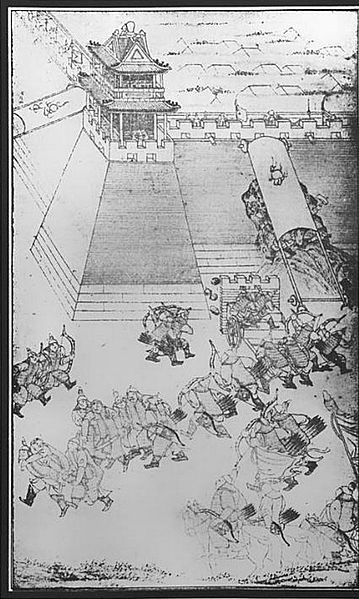The thunder crash bomb, also known as the heaven-shaking-thunder bomb, was one of the first bombs or hand grenades in the history of gunpowder warfare. It was developed in the 12th-13th century Song and Jin dynasties. Its shell was made of cast iron and filled with gunpowder. The length of the fuse could be adjusted according to the intended throwing distance.
Ceramic thunder crash bomb excavated from Takashima shipwreck, October 2011, dated to the Mongol invasions of Japan (1271-1284 AD).
An illustration of a thunderclap bomb as depicted in the 1044 text Wujing Zongyao. The top item is a through awl and the bottom one is a hook awl, used to ignite the projectile before it was hurled.
A Mongol thunder crash bomb thrown against a charging Japanese samurai during the Mongol invasions of Japan after founding the Yuan Dynasty, 1281.
The samurai Takezaki Suenaga facing Mongol and Korean arrows and bombs.
A bomb is an explosive weapon that uses the exothermic reaction of an explosive material to provide an extremely sudden and violent release of energy. Detonations inflict damage principally through ground- and atmosphere-transmitted mechanical stress, the impact and penetration of pressure-driven projectiles, pressure damage, and explosion-generated effects. Bombs have been utilized since the 11th century starting in East Asia.
An iron grenade with a wooden fuse from 1580
A "wind-and-dust" bomb depicted in the Ming Dynasty book Huolongjing. The pot contains a tube of gunpowder, and was thrown at invaders.
An illustration depicting bombs thrown at Manchu assault ladders during the siege of Ningyuan, from the book Thai Tsu Shih Lu Thu (Veritable Records of the Great Ancestor) written in 1635. The bombs are known as "thunder crash bombs."
Thunder crash bombs from the Mongol invasions of Japan (13th century) that were excavated from a shipwreck near the Liancourt Rocks







